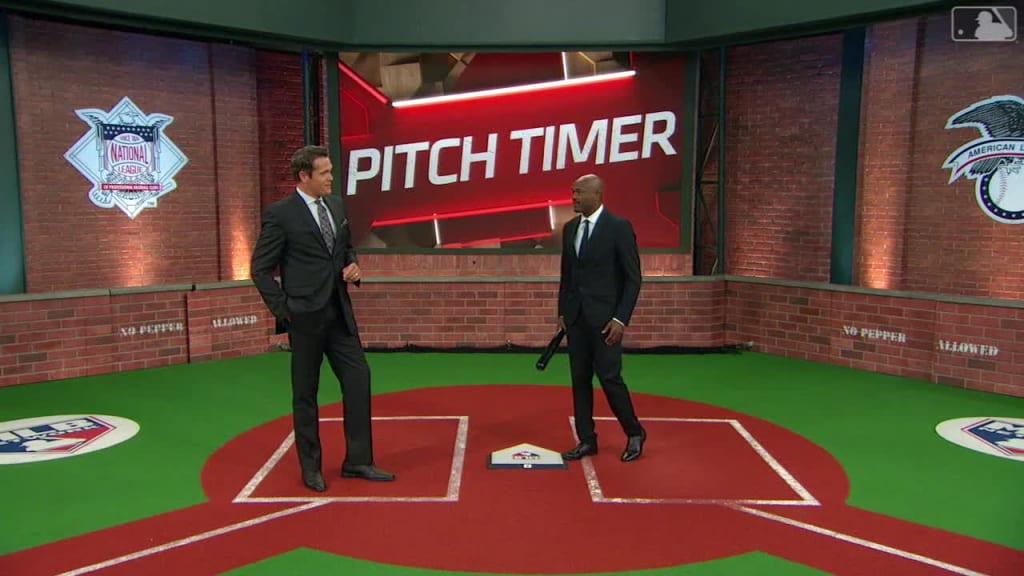MLB sends clarifications on new rules to clubs
This browser does not support the video element.
Major League Baseball sent a memo to clubs on Wednesday outlining several clarifications on the rule changes that have been implemented for the 2023 regular season, including a pitch timer, infield shift restrictions and larger bases.
Thus far, the average game time in Spring Training has been 2 hours, 36 minutes -- a 25-minute decrease from Spring Training last year. The number of violations per game has declined steadily over the course of the spring as players have become comfortable with the new rules. In the first week of the exhibition season, there were 2.03 violations per game. This past week, there were 1.03 per game.
Nothing in the memo obtained by MLB.com materially changes the rules as originally outlined. Rather, the guidance, which came following feedback from the MLB Players’ Association and in response to club and umpire questions, cover minor details related to the implementation of the rules. This is the fifth memo of its kind sent this spring and is expected to be the final clarification prior to Opening Day.
The seven clarifications included in the memo (six involving the pitch timer, one involving the shift restrictions) are as follows:
This browser does not support the video element.
Pitcher timer regulations
1) Brushbacks and aggressive swings: If a batter is brushed back or knocked down by a pitch, the Field Timing Coordinator (FTC) operating the pitch timer will delay the start of the timer until the batter has the chance to gather himself and return to the edge of the batter’s box. If the umpire determines that the FTC has reset the timer too quickly, the umpire will waive off the clock and reset the timer when play is ready to resume. MLB has now added that if a batter takes an aggressive swing that causes him to lose his footing or have his equipment dislodged (such as the batter’s helmet coming off), the FTC will delay the start of the timer until the batter regained his footing and collected his equipment.
2) Pitchers covering first base and backing up third base or home plate: If a pitcher leaves his position to cover first base, the FTC will delay the start of the 30-second between-batter timer until the pitcher returns to the infield grass. If the pitcher leaves his position to back up third base or home plate, the FTC will delay the start of the 30-second timer until the pitcher returns to fair territory.
3) Catcher ending an inning on base, at bat or on deck: If a catcher ends an inning on base, at bat or on deck, the home-plate umpire will determine whether the catcher requires additional time.
If the catcher has made a reasonable effort to comply with the inning-break timer, it is within the umpire’s discretion to waive off the timer and grant additional time. The umpire can signal to the FTC to shut off the inning-break timer until the catcher is in position. MLB has now added that in this case the umpire can then signal to the pitcher that he has one warmup pitch remaining, and the catcher can get his throw down to second base to stay loose. The umpire will reset the timer to 15 seconds when it is determined that play may resume.
• All your questions about the new rules, answered
4) Bat boys/girls: Clubs are expected to have bat boys/girls in each dugout who can quickly assist players and umpires to comply with the pace of game procedures by retrieving bats and other equipment, supplying the umpire with new baseballs, etc. The bat boys/girls must meet with the visiting club before each series to discuss the preferences of the visiting players. MLB will monitor the performance of bat boys/girls during the season to ensure compliance.
5) Batter timeouts: Batters will continue to be permitted one timeout per plate appearance. The memo clarifies that when a batter has used his timeout, the timer will restart when the batter returns to the batter’s box or when the batter otherwise indicates to the umpire that he is ready for the timer to be reset. This way the batter doesn’t have to be in the box for a full 20 seconds. The umpire will determine a batter has used his one timeout whenever the batter steps out of the batter’s box after entering the box and becoming alert to the pitcher.
However, a hitter may step out of the batter’s box with more than 8 seconds remaining on the timer as long as the pitcher is not engaged with the rubber at the time the batter steps out. If the batter steps out in this situation, the timer will continue to run and the hitter must return to the batter’s box and become alert to the pitcher with at least eight seconds remaining. If a batter uses his timeout and is replaced by a pinch-hitter later in the plate appearances (such as in the event of an injury), the pinch-hitter will not receive an additional timeout.
6) PitchCom malfunctions: In the event of a pitcher or catcher having an issue with the PitchCom system, the pitcher or catcher should request time and notify the umpire of the issue. If the umpire believes the player is not attempting to circumvent the pace of game procedures, the umpire will grant time and allow the players to resolve the issue.
A coach may visit the mound to provide players with a new receiver or transmitter, and this visit will not count against the club’s allotment of five mound visits (as long as topics unrelated to the PitchCom system are not discussed). Umpires will not grant additional time to a pitcher or catcher who forgets to bring a PitchCom device with them to the field.
This browser does not support the video element.
Shift restrictions
1) Replay reviews: A defensive team may always ask to review an umpire’s decision that the defense did not comply with the shift restrictions rule. However, the offense may now only review the umpire’s judgment with respect to the infielder who was the first player to touch the ball after a pitch. For example, on a ground ball to the shortstop, the offensive team could only ask for a review of whether the shortstop was in violation of the shift rule and would not be permitted to review whether the first, second or third baseman violated the rule.

